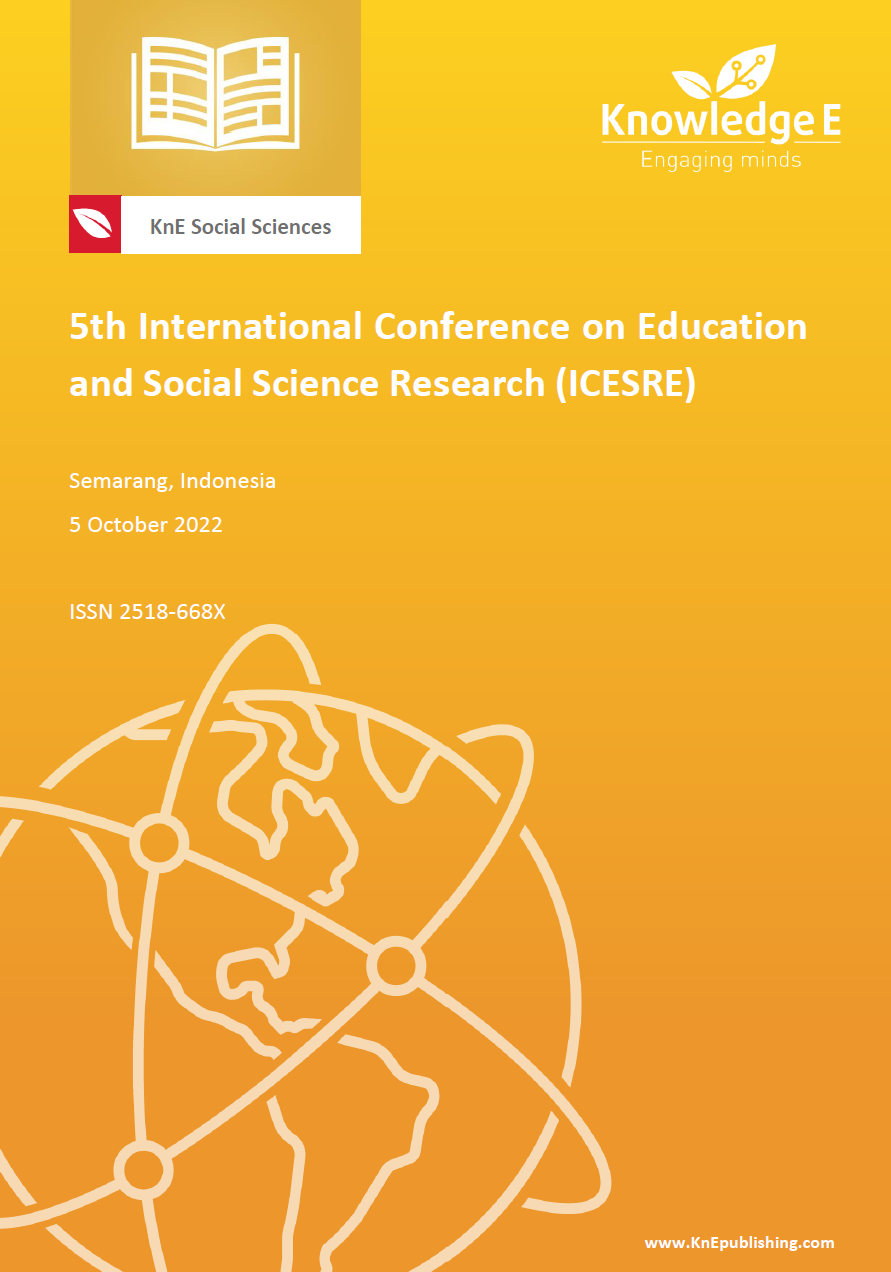A Framework for Scaffolding Learners' Self-Regulation in a Flipped Classroom Learning Environment
DOI:
https://doi.org/10.18502/kss.v7i19.12495Abstract
Self-regulated learning is learning that is derived from a student’s self-regulated thoughts and it is strategically oriented towards their learning goals. The need to guide and monitor students’ self-regulation is crucial since it has become an integral part of their learning process. Throughout the process, technologies also have been integrated into the educational scene, and one of the approaches that exist nowadays is flipped classrooms. Previous research has proven that if a student’s self-regulation is being monitored, their performance might as well increase, along with their selfregulation skills. As a result, this paper proposes a framework for scaffolding students’ self-regulation in a flipped classroom learning environment. The proposed framework may be useful to practitioners and online learning instructors. The implication of a self-regulated flipped classroom approach towards students’ self-regulation and students’ achievement in learning have been discussed. Finally, the success factors for implementing the proposed framework and some future research directions have also been discussed.
Keywords: scaffolding; self-regulated; flipped classroom; performance
References
[2] McLaughlin JE, Griffin LM, Esserman DA, Davidson CA, Glatt DM, Roth MT, et al. Pharmacy student engagement, performance, and perception in a flipped satellite classroom. American Journal of Pharmaceutical Education. 2013;77.
[3] Sun JCY, Wu YT, Lee WI. The effect of the flipped classroom approach to Open CourseWare instruction on students’ self-regulation. British Journal of Educational Technology. 2016;48:713–729.
[4] Liu H, Lan K, Jenkins J. Technology-enhanced strategy use for second language vocabulary acquisition. English Teaching & Learning. 2014;38:105–132.
[5] Lai CL, Hwang GJ. A self-regulated flipped classroom approach to improving students’ learning performance in a mathematics course. Computers & Education. 2016;100:126–140.
[6] Dean D, Davies R, Ball N. Flipping the classroom and instructional technology integration in a college-level information systems spreadsheet course. Educational Technology Research and Development (ETR&D). 2013; 61:563–580.
[7] Alvarez B. Flipping the classroom: Homework in class, lessons at home. Learning First. 2011. Available from: http://www.learningfirst.org/flipping-classroom-homeworkclass- lessons-home
[8] Rahman AA, Aris B, Rosli MS, Mohamed H, Abdullah Z, Zaid NM. Significance of preparedness in flipped classroom. In Paper presented at the 3rd International Conference on Internet Services Technology And Information Engineering 2015 (ISTIE 2015), Kuta, Bali, Indonesia.
[9] Zimmerman B. Becoming a self-regulated learner: An overview. Theory into Practice. 2002;41:64–70.
[10] Long Y, Aleven V. Active learners: Redesigning an intelligent tutoring system to support self-regulated learning. Paper presented at European Conference on Technology Enhanced Learning EC-TEL 2013: Scaling up Learning for Sustained Impact. p. 490–495.
[11] Jones JA. Scaffolding self-regulated learning through student-generated quizzes. Active Learning in Higher Education. 2017;20.
[12] Ernesto P. A review of self-regulated learning: six models and four directions for research. Frontiers in Psychology. 2017;8:1–28.
[13] Wolters CA, Taylor DJ. A self-regulated learning perspective on student engagement. Handbook of Research on Student Engagement. 2012:635–651.
[14] Pizzimenti MA, Axelson RD. Assessing student engagement and self-regulated learning in a medical gross anatomy course. Anatomical Science Education. 2015;8.
[15] Mutawah MA, Thomas R, Khine MS. Investigation into self-regulation, engagement in learning mathematics and science and achievement among bahrain secondary school students. International Electronic Journal of Mathematics Education. 2017;12:633–653.
[16] Ellis JM, Helaire LJ. The effects of adolescent self-regulated learning on engagement in a college access program: An exploratory study. AERA Open. 2018;4.
[17] Eom S. The effects of student motivation and self-regulated learning strategies on student’. 2015 Proceedings SIGED: IAIM Conference 2015, Association for Information Systems.
[18] Stefanou CE, Lord SM, Prince MJ, Chen JC. Effect of classroom gender composition on students’ development of self-regulated learning. International Journal of Engineering Education. 2014;30:1–10.
[19] Jarvela S, Kirschner PA, Panadero E, Malmberg J, Phielix C, Jaspers J, et al. Enhancing socially shared regulation in collaborative learning groups: designing for CSCL regulation tools. Educational Technology Research and Development. 2015;63:125–142.
[20] van Alten DCD, Phielix C, Janssen J, Kester L. Effects of self-regulated learning prompts in a flipped history classroom. Computers in Human Behavior. 2020;108.
[21] van Laer S, Elen J. In search of attributes that support self-regulation in blended learning environments. Education and Information Technologies. 2017;22:1395– 1454.
[22] Devolder A, van Braak J, Tondeur J. Supporting self-regulated learning in computerbased learning environments: Systematic review of effects of scaffolding in the domain of science education. Journal of Computer Assisted Learning. 2012;28.
[23] Moos D, Bonde C. Flipping the classroom: Embedding self-regulated learning prompts in videos. Technology, Knowledge and Learning. 2016;21.
[24] Zimmerman BJ, Moylan A. Self-regulation: Where metacognition and motivation intersect. Handbook of metacognition in education. 2009; 299–315.
[25] Dent A, Koenka A. The relation between self-regulated learning and academic achievement across childhood and adolescence: A meta-analysis. Educational Psychology Review. 2015;28.

